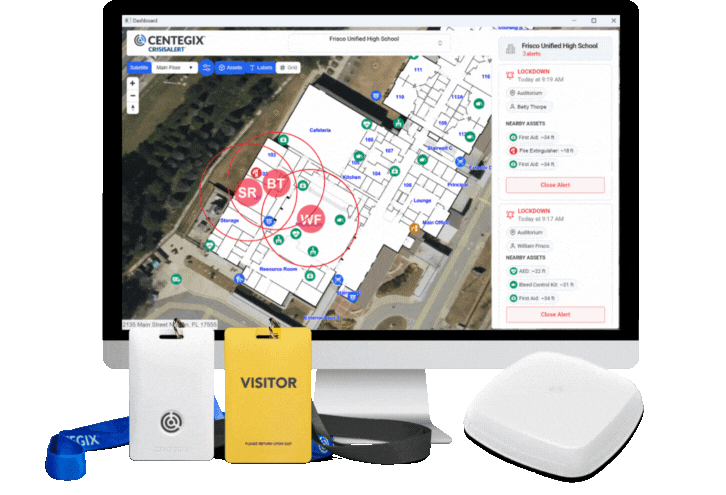Little emergencies happen in schools every day, taking teachers’ attention away from their classes. Unexpected illnesses or student disputes, for instance, wouldn’t seem to trigger a traditional school alert system. However, these emergencies can claim over 18 days’ worth of classroom instruction each year.
To an educator, an emergency is yet another hurdle to overcome during an already busy workday. To a 13-year-old with a surprise nosebleed, it can be the difference between a productive school day or informational gaps in their education.
So, how can a school emergency alert system help with instructional time? Implementing a multi-level approach to safety can help reclaim instructional time on multiple fronts. The best school emergency alert systems can:
- deescalate or deter situations before they become disruptive
- help teachers resume class sooner by accelerating emergency response times
- provide administrators with data for intervention plans or classroom adjustments
- help reduce disruption from late check-ins and early student dismissals

How Instructional Gaps Widen
No matter how small, these emergency moments create instructional gaps that can grow wider, quickly.
In a poll of American Federation of Teachers members, 19 percent of teachers reported two to three hours of lost instructional time every week, and 17 percent reported four or more hours a week due to students’ disruptive behavior. When assessing this over a week, that may sound small. But let’s do the math.
On average, there are roughly 36 “weeks of instruction in a school year.” That means, if a student lost 2-4 hours each week of instructional time due to disruptions, this student could lose anywhere from 71 to 142+ hours of instructional time every school year. A student could miss 18 or more full school days’ worth of classroom instruction each year while physically in the classroom.
An Association for Supervision and Curriculum Development report in which teachers estimated time lost at more than six minutes for every hour. “Scaling these estimates by 5.5 hours per day and 180 school days per year suggests that students lose between 10 to 20 days of instructional time for the year. This is enough time to categorize every student in the district as truant or even chronically absent—all while they are in school.”
Much has been written about the negative impact of distraction on students’ ability to learn, but until COVID-19, most evidence was qualitative or anecdotal.
Now, researchers and educators estimate the instructional gaps caused by COVID-19 lockdowns will take time and effort to overcome. In a 2023 article, The National Assessment of Educational Progress (NAEP) describes the situation: “A key takeaway from the latest results is that behind the overall declines in reading and mathematics scores, you see nearly all student groups are facing academic setbacks when compared with results shortly before the pandemic.”
Teachers are already dealing with significant shortages in their students’ educational achievement levels. Reducing instructional time lost to behavioral issues and emergency responses is vital for the current generation of students.
A report from the Northwest Evaluation Association puts numbers to the achievement loss, “At the end of the 2022–23 school year, across all grade levels, the average student will require the equivalent of 4.1 months of additional schooling to catch up to pre-COVID levels in reading and 4.5 months in math.”
For this generation of students, every second in the classroom matters. Preserving the valuable instructional time students are already present for is essential to their ultimate educational success.
The Impact for Teachers
According to an EdWeek national teacher survey, teachers work an average of 54 hours each week, only 25 of which are actually spent teaching students.
Classroom disruptions take a toll on teachers. In the Teachers’ Reports of Disruptive Student Behaviors and Staff Rule Enforcement published by the National Center for Education Statistics, 32 percent of public school teachers reported disruptive student behavior, and 37 percent reported tardiness and skipping class interfered with instructional time.
Increased student disruption has been shown to significantly harm teachers’ well-being. Disruptive classrooms can overwhelm even the most experienced educators and leave them feeling discouraged. Managing a classroom in a constant state of chaos combined with the inability to effectively manage disruptions can lead to immense stress, fatigue, and burnout which could push many teachers to consider a change in their career path.
While this problem may sound complex, the solution can be simple: Protect your teachers’ time.
In Where Teachers Thrive: Organizing Schools for Success, Susan Moore Johnson said, “The schools where teachers thrive are actually schools that are very well managed by principals who protect teachers from interruptions and unrealistic demands.”
When teachers face challenging classrooms, they need to know they are supported. Administrators can provide their staff with school safety technology that allows them to rapidly request assistance in emergencies and feel confident help is on the way. The most effective solutions not only assist during active emergencies but also provide data to assist administrators in classroom assignments, behavior interventions, and teacher training.
When administrators plan ahead and foster a culture of safety within their campus, teachers will have higher job satisfaction. Rapid school safety technology can give them the tools they need to feel safe, handle emergencies, and maximize classroom instruction.
Close Your Instructional Gaps with the CENTEGIX Safety Platform™
Teachers who are equipped with an incident response solution can summon help from their colleagues before small-scale behaviors escalate into serious and more disruptive situations. A campus-wide school safety platform can help identify emergencies faster (big and small), notify administrators, security personnel, and even emergency responders in real time, and accelerate response times. Acting quickly and effectively increases safety, reduces disruptions, and maximizes instructional periods.
The CENTEGIX Safety Platform has precise alert location notifications, down to the floor and room number, giving personnel visibility of where an incident is happening, which helps responders reach the scene faster. The CENTEGIX Safety Platform specifically impacts instructional time in several ways, including:
-
- CrisisAlert is a wearable panic button activated discreetly with the push of a button enabling teachers to request help without skipping a beat.
- Visitor management features can also simplify your tardy student and early dismissal processes allowing teachers to spend less time on housekeeping items and more time on instruction.
- CENTEGIX Safety Blueprint is an intelligent digital map of your campus that provides precise alert locations, safety assets, and other valuable data, allowing campus responders to arrive and handle incidents quickly.
One Kansas elementary school teacher using CENTEGIX CrisisAlert needed help de-escalating a situation with a student and described her experience this way:
“I like that our CrisisAlert button is very subtle. Other methods, such as pulling out a walkie-talkie or calling on the phone, take time and draw more attention to our students.”
A Florida high school teacher said the tool helped eliminate conflict immediately because administrators “know who triggered the alert and where they are in the building.”
An Oklahoma teacher had a student fall and seriously hurt his ankle. “I couldn’t carry him; he was in terrible pain, and I needed help. I used my badge and help came running,” she said. “Not only did help come running, but all the right people came. If I sent a student to the office, it still meant someone might have to find the nurse and then come back. This way, she was there immediately.”
Full-campus visibility and room-level specificity mean a rapid and appropriate response, de-escalation of the situation, and prevention of further distractions in that room or any classrooms in the vicinity.
Do You Need Help Protecting Your Teachers’ Time?
CENTEGIX helps schools across the United States protect their students, their campuses, and their teachers’ instructional time with our school safety solutions. The CENTEGIX Safety Platform is easy to integrate with existing infrastructure, and our team is always eager to help.
If you and your school are looking for ways to create a culture of safety and reclaim instructional time, CENTEGIX can help you implement the right solution for your school. Reach out to a specialist today to schedule a demo.















